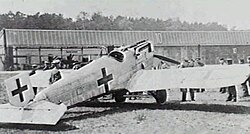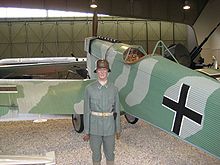Junkers DI
| Junkers DI | |
|---|---|

|
|
| Type: | Fighter plane |
| Design country: | |
| Manufacturer: | |
| First flight: |
April 1918 |
| Commissioning: |
October 1918 |
| Number of pieces: |
28 |
The Junkers DI (factory designation J 9 ) is a Junkers - Fokker AG fighter aircraft that was used by the German air force as a reconnaissance aircraft at the end of the First World War .
History and construction
Following on from the Junkers J 7 designed by Junkers & Co. in 1917, the J 9 was developed in the spring of 1918 by Junkers-Fokker AG, which had been founded shortly before, in a similar design with a larger span and a more powerful engine and an automobile-like front radiator. As a novelty, instead of conventional ailerons, rotating wing tips were used on the J 7 , but these did not prove to be successful, as this made the vibration of the wings too strong. Junkers therefore returned to normal ailerons on the J 9.
The DI was built as an all-metal aircraft made of corrugated duralumin sheet metal and was therefore extremely stable and more tolerant of adverse weather conditions. The first flight took place in April 1918. The aircraft was equipped with a 180 hp Mercedes D IIIa engine and took part in the fighter aircraft competition in Berlin-Adlershof in May / June 1918 ; another with a BMW IIIa engine with 185 hp was presented in the competition in October 1918. The DI proved to be extremely fast and bulletproof. However, due to its unusual appearance, it received a mixed response and was only recommended by the front-line pilots Bruno Loerzer and Hermann Göring for fighting tethered balloons and airships , while Gotthard Sachsenberg preferred the DI to other hunters.
This type was in October 1917, the aircraft division of the production under pressure from the military authorities Junkers & Co. forcibly with the Fokker Aeroplanbau in Schwerin for Junkers-Fokker Werke AG (Jfa) based Dessau merged . Anthony Fokker influenced the development of Junkers aircraft. However, the cooperation only lasted until the spring of 1919, when the Junkers-Fokker factories were renamed Junkers Flugzeugwerke AG .
The J 9 were equipped with a 160 hp six-cylinder in-line engine of the Mercedes D IIIaü type and thus reached a top speed of around 220 km / h. Tests in November 1918 with a BMW IIIa engine with 185 hp are said to have achieved 240 km / h.
Due to the difficult supply situation and the complex all-metal construction, an order for 20 machines had already been placed in May 1918, of which only about 12 were delivered. The later models were equipped with the Benz Bz IIIaü engine.
At least one DI was tested with a 195 hp eight-cylinder V-engine of the Benz Bz IIIb type.
commitment
Only a few of the 15 or so copies made by Junkers and 13 by Fokker reached the front in Flanders from October 1918 .
Some Junkers DI remained in service in the Baltic States until 1919, where German Freikorps fought against the Bolsheviks . Lt zS Sachsenberg described the Junkers DI as the best aircraft in changeable weather conditions.
Technical specifications
| Parameter | DI |
|---|---|
| crew | 1 |
| length | 7.25 m |
| span | 9.08 m |
| height | 2.25 m |
| Wing area | 14.12 m² |
| Empty mass | 654 kg |
| Takeoff mass | 840 kg |
| Top speed | 220 km / h |
| Marching speed | 200 km / h |
| Rise time | 2.18 min at 1000 m 5.08 min at 2000 m 6.30 min at 3000 m 12.30 min at 5000 m 22.15 min at 6000 m |
| Summit height | 7500 m |
| Max. Range | 300 km |
| Flight duration | 1:30 h |
| water-cooled 6-cylinder in- line engine | Benz Bz IIIaü , 185 hp (136 kW) |
| Armament | 2 rigid, synchronized 7.9 mm LMG 08/15 |
Received aircraft

The only original airplane is on display in the Musée de l'Air et de l'Espace . It was left on a field airfield during the retreat in November 1918 and fell into the hands of the advancing French troops.
See also
literature
- Enzo Angelucci, Paolo Matricardi: The planes. From the beginning to the First World War . Falken-Verlag, Wiesbaden 1976, ISBN 3-8068-0391-9 , ( Falken manual in color ).
- Karlheinz Kens, Hanns Müller: The aircraft of the First World War 1914-1918 . Heyne, Munich 1973, ISBN 3-453-00404-3 .
- Günter Kroschel, Helmut Stützer: The German military aircraft 1910-1918 . Lohse-Eissing, Wilhelmshaven 1977, ISBN 3-920602-18-8 .
- Kenneth Munson: Warplanes. Fighter and training aircraft 1914-1919 . Füssli, Zurich 1968, ( Aircraft of the World ), No. 18.
- Heinz Nowarra: The Development of Aircraft 1914-1918 . Lehmanns, Munich 1959.
- Karl Pawlas: German aircraft 1914–1918. A documentation . Publizistisches Archiv Pawlas, Nuremberg 1976, ISBN 3-88088-209-6 , pp. 63–65.
- Wolfgang Mühlbauer: Junkers J 9 and J 10. The trailblazers . In: Flugzeug Classic . No. 5 , 2008, ISSN 1617-0725 , p. 28-33 .
Web links
- Junkers J9 on Junkers.de
- http://users.skynet.be/Emmanuel.Gustin/faq/ger_mil.txt
- http://www.bredow-web.de/Luftwaffenmuseum/Historisch/Junkers_J-9/junkers_j-9.html Ju DI replica
Remarks
- ↑ According to Kens 1973, 41 were made. In addition to the prototype, 40 aircraft were presumably ordered but not completely delivered
- ↑ also equipped with a Mercedes D.IIIa engine with 180 hp (132 kW) and a BMW IIIa with 185 hp (136 kW)
Individual evidence
- ↑ contradicting information, here reference to Kroschel 1977.
- ↑ Musée de l'Air et de l'Espace: ( Page no longer available , search in web archives ) Info: The link was automatically marked as defective. Please check the link according to the instructions and then remove this notice. JUNKERS J.9 (TUE), accessed March 2, 2009



